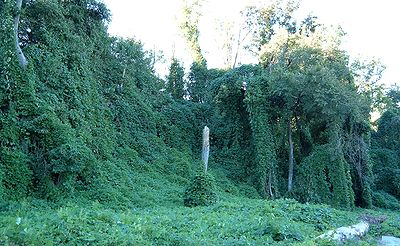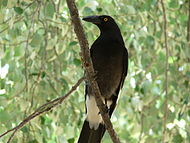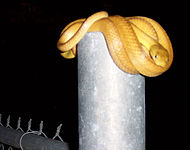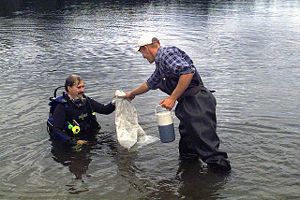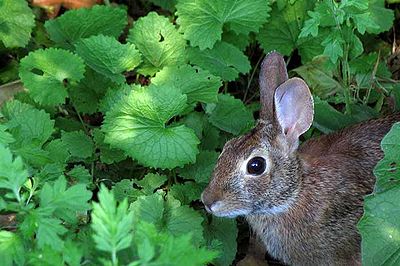
Invasive species
Did you know...
SOS Children has tried to make Wikipedia content more accessible by this schools selection. Click here to find out about child sponsorship.
Invasive species is a phrase with several definitions. The first definition expresses the phrase in terms of non-indigenous species (e.g. plants or animals) that adversely affect the habitats they invade economically, environmentally or ecologically. It has been used in this sense by government organizations as well as conservation groups such as the IUCN.
The second definition broadens the boundaries to include both native and non-native species that heavily colonize a particular habitat.
The third definition is an expansion of the first and defines an invasive species as a widespread non-indigenous species. This last definition is arguably too broad as not all non-indigenous species necessarily have an adverse effect on their adopted environment. An example of this broader use would include the claim that the common goldfish (Carassius auratus) is invasive. Although it is common outside its range globally, it almost never appears in harmful densities.
Due to the ambiguity of its definition, the phrase invasive species is often criticized as an imprecise term within the field of ecology. This article concerns the first two definitions; for the third, see introduced species.
Conditions that lead to invasion
Scientists propose several mechanisms to explain invasive species, including: species-based mechanisms and ecosystem-based mechanisms, most likely, it is a combination of several mechanisms that cause an invasive situation to occur since most introduced plants and animals do not become invasive.
Species-based mechanisms
Species-based characteristics focus on competition. While all species compete to survive, invasive species appear to have specific traits or combinations of specific traits that allow them to outcompete native species. Sometimes they just have the ability to grow and reproduce more rapidly than native species; often it's more complex, involving a multiplex of traits and interactions.
Several traits have been singled out by researchers as predictors of invasive ability. For example in plants, the ability to reproduce both asexually (vegetatively) as well as sexually, rapid growth, early sexual maturity, high reproductive output, the ability to disperse young widely, tolerance of a broad range of environmental conditions, high phenotypic plasticity and allelopathy are all abilities that might aid an invasive plant in establishing and proliferating in a new environment.
Studies seem to indicate that certain traits mark a species as potentially invasive. One study found that of a list of invasive and noninvasive species, 86% of the invasive species could be identified from the traits alone. Another study found that invasive species tended to only have a small subset of the invasive traits and that many of these invasive traits were found in non-invasive species as well indicating that invasiveness involves complex interaction not easily categorized. Common invasive species traits include fast growth, rapid reproduction, high dispersal ability, phenotypic plasticity (the ability to alter one’s growth form to suit current conditions), tolerance of a wide range of environmental conditions, ability to live off of a wide range of food types, asexual reproduction, and association with humans. The single best predictor of invasiveness, however, is whether or not the species has been invasive elsewhere. Typically an introduced species must survive at low population densities before it becomes invasive in a new location. At low population densities, it is often difficult for the introduced species to reproduce and maintain its self in a new location, but often due to human actions a species might be transported to a location a number of times before it become established. Humans repeated patterns of movement from one location to another, such as ships sailing to and from ports or cars driving up and down highways, allow for species to have multiple opportunities for establishment (also known as a high “ propagule pressure”).
An introduced species might become invasive if it can out compete native species for resources such as nutrients, light, physical space, water or food. Some species when introduced into a new environment lack the competition and predation they evolved under in their native environments freeing them to proliferate quickly. Ecosystems where all available resources are being used to their full capacity by native species can be modeled as zero-sum systems, where any gain for the invader is a loss for the native. However, such unilateral competitive superiority (and instant, equivalent extinction of native species with increased populations of the invader) is not the rule. Invasive species often coexist with native species for an extended time and gradually the superior competitive ability of an invasive species become apparent when its population grows larger and denser often after it adapts to its new location.
An invasive species might be able to use resources previously unavailable to native species, such as deep water sources accessed by a long taproot, or an ability to live on previously uninhabited soil types. For example, barb goatgrass (Aegilops triuncialis), can be found in its introduced range in California on serpentine soils, which have low water-holding capacity, low nutrients, high Mg/Ca ratio, and possible heavy metal toxicity. Plant populations on these soils tend to show low density but goatgrass can form dense stands on these soils crowding out native species that have not adapted well to growing on serpentine soils. Invasive species are either plant or animal, from another area and over-compete other native species living in the area.
Facilitation is the mechanism by which some species can alter their environment through chemicals or manipulation of abiotic factors, usually to make it less favorable for other species to compete against them, allowing the species to grow or reproduce. One such facilitative mechanism is allelopathy, also known as chemical competition. In allelopathy a plant or in Interference Competition a bacterium will secrete chemicals which make the surrounding soil uninhabitable, or at least inhibitory, to other competing species.
One example of this is the knapweed ( Centaurea diffusa). This Eastern European weed has spread its way through the western United States. Experiments show that 8-Hydroxyquinoline, a chemical produced at the root of C. diffusa, has a negative effect only on plants that have not co-evolved with C. diffusa. Such co-evolved native plants have also evolved defenses, and C. diffusa does not appear in its native habitat to be an overwhelmingly successful competitor. This result shows how difficult it can be to predict whether a species will be invasive just from looking at its behaviour in its native habitat, and demonstrates the potential for novel weapons to aid in invasiveness ).
Changes in fire regimes are another form of facilitation. Bromus tectorum, originally from Eurasia, is highly fire-adapted. It not only spreads rapidly after burning, but actually increases the frequency and intensity (heat) of fires, by providing large amounts of dry detritus during the dry fire season in western North America. In areas where it is widespread, it has altered the local fire regime so much that native plants cannot survive the frequent fires, allowing B. tectorum to further extend and maintain dominance in its introduced range.
Facilitation also occurs when one species physically modifies a habitat and that modification is advantageous to other species. For example, zebra mussels increase habitat complexity on lake floors providing nooks and crannies in which invertebrates live. This increase in complexity, together with the nutrition provided by the waste products of mussel filter-feeding increases the density and diversity of benthic invertebrate communities.
Ecosystem-based mechanisms
In ecosystems the amount of resources available and how much of those resources are utilized by organisms, determine the effects of new additions to the ecosystem. In stable ecosystems equilibrium exists in the utilization of available resources.
When changes occur in an ecosystem, like forest fires removing large stands of vegetation in an area, normal succession would favour certain native grasses and forbs, but with the introduction of a species that can multiply and spread faster on open ground than the native species, the balance is changed and the resources that would have been used by the native species are now utilized by an invader thus impacting the ecosystem and changing its composition of organisms and their use of available resources. The data shows that nitrogen and phosphorus are often the limiting factors for a situation such as this.
Every species has a role to play in its native ecosystem; some species fill large and varied roles while others are highly specialized. These roles are known as niches. Some invading species are able to fill niches that are not utilized by native species, and they also can create niches that did not exist.
When changes occur to ecosystems, conditions change that impact the dynamics of species interaction and niche development. This can cause once rare species to replace other species, because they now can utilize greater available resources that did not exist before, an example would be the edge effect. The changes can favour the expansion of a species that without the change would not be able to colonize areas and niches that did not exist before.
This mechanism describes a situation where the ecosystem in question has suffered a disturbance of some sort, which changes the fundamental nature of the ecosystem.
Ecology
Although an invasive species is often defined as an introduced species that has spread widely and causes harm, some species native to a particular area can, under the influence of natural events such as long-term rainfall changes or human modifications to the habitat, increase in numbers and become invasive.
All species on Earth go through periods of increasing and decreasing population numbers, in many cases accompanied by expansion and contraction of range. Human “alterations” on the landscape are especially significant. Anthropogenic alteration of an environment may enable the expansion of a species into a geographical area where it had not been seen before and thus that species could be described as invasive. In essence, one must define "native" with care, as it refers to some natural geographic range of a species, and is not coincident with human political boundaries. Whether noticed increases in population numbers and expanding geographical ranges is sufficient reason to regard a native species as "invasive" requires a broad definition of the term but some native species in disrupted ecosystems can spread widely and cause harm and in that sense become invasive. For example the Monterey Cypress is a rare and endangered endemic naturally occurring only in two small stands in California. They are being exterminated as exotic invasive species less than 50 miles (80 km) from their native home.
Traits of invaded ecosystems
In 1958, Charles S. Elton argued that ecosystems with higher species diversity were less subject to invasive species because of fewer available niches. Since then, other ecologists have pointed to highly diverse, but heavily invaded ecosystems and have argued that ecosystems with high species diversity seem to be more susceptible to invasion. In the end, this debate seems largely to hinge on the spatial scale at which invasion studies are performed, and the issue of how diversity affects community susceptibility to invasion remains unresolved. Small-scale studies tend to show a negative relationship between diversity and invasion, while large-scale studies tend to show a positive relationship. The latter result may be an artifact of invasive or non-native species capitalizing on increased resource availability and weaker overall species interactions that are more common when larger samples are considered.
Invasion is more likely if an ecosystem is similar to the one in which the potential invader evolved.. Island ecosystems may be prone to invasion because their species are “naïve” and have faced few strong competitors and predators throughout their existence, or because their distance from colonizing species populations makes them more likely to have “open” niches. An example of this phenomenon is the decimation of the native bird populations on Guam by the invasive brown tree snake. Alternately, invaded ecosystems may lack the natural competitors and predators that keep introduced species in check in their native ecosystems, a point that is also seen in the Guam example. Lastly, invaded ecosystems have often experienced disturbance, usually human-induced. This disturbance may give invasive species, which are not otherwise co-evolved with the ecosystem, a chance to establish themselves with less competition from more adapted species
Vectors
Non-native species have many vectors, including many natural ones, but most of the species considered "invasive" are associated with human activity. Natural range extensions are common in many species, but the rate and magnitude of human-mediated extensions in these species tend to be much larger than natural extensions, and the distances that species can travel to colonize are also often much greater with human agency.
One of the earliest human influenced introductions involves prehistoric humans introducing the Pacific rat (Rattus exulans) to Polynesia. Today, non-native species come from horticultural plants either in the form of the plants themselves or animals and seeds carried with them, from animals and plants released through the pet trade. Invasive species also come from organisms stowed away on every type of transport vehicle imaginable, to name a few unintentional vectors. For example, ballast water taken up at sea and released in port is a major source of exotic marine life.
Species have also been introduced intentionally. For example, to feel more "at home", American colonists formed "Acclimation Societies" that repeatedly released birds that were native to Europe until they finally established along the east coast of North America.
Economics play a major role in exotic species introduction. The scarcity and demand for the valuable Chinese mitten crab is one explanation for the possible intentional release of the species in foreign waters.
Impact
Ecological impacts
Biological species invasions alter ecological systems in a multitude of ways. Worldwide an estimated 80% of endangered species could suffer losses due to competition with or predation by invasive species. Pimentel also reports that introduced species, such as corn, wheat, rice, and other food crops, and cattle, poultry, and other livestock, now provide more than 98% of the U.S. food system at a value of approximately $800 billion per year." As highly adaptable and generalized species are introduced to environments already impacted by human activities, some native species may be put at a disadvantage to survive while other species survival is enhanced.
Land clearing and human habitation put significant pressure on local species and disturbed habitat is often prone to invasions that can have adverse effects on local ecosystems, changing ecosystem functions. A species of wetland plant known as ʻaeʻae in Hawaiʻi (the indigenous, Bacopa monnieri) is regarded as a pest species in artificially manipulated water bird refuges because it quickly covers shallow mudflats established for endangered Hawaiian stilt (Himantopus mexicanus knudseni), making these undesirable feeding areas for the birds. Sometimes, multiple successive introductions of different nonnative species can have interactive effects, where the introduction of a second non-native species can enable the first invasive species to flourish. Examples of this are the introductions of the amethyst gem clam (Gemma gemma) and the European green crab (Carcinus maenas). The gem clam was introduced into California's Bodega Harbor from the East Coast of the United States a century ago. It had been found in small quantities in the harbour but had never displaced the native clam species (Nutricola spp.). In the mid 1990s, the introduction of the European green crab, found to prey preferentially on the native clams, resulted in a decline of the native clams and an increase of the introduced clam populations.
In the Waterberg region of South Africa, cattle grazing over the past six centuries has allowed invasive scrub and small trees to displace much of the original grassland, resulting in a massive reduction in forage for native bovids and other grazers. Since the 1970s large scale efforts have been underway to reduce invasive species; partial success has led to re-establishment of many species that had dwindled or left the region. Examples of these species are giraffe, Blue Wildebeest, impala, kudu and White Rhino.
Invasive species can change the functions of ecosystems. For example invasive plants can alter the fire regime (cheatgrass, Bromus tectorum), nutrient cycling (smooth cordgrass Spartina alterniflora), and hydrology ( Tamarix) in native ecosystems. Invasive species that are closely related with rare native species have the potential to hybridize with native species. Harmful effects of hybridization have led to a decline and even extinction of native species. For example, hybridization with introduced cordgrass, Spartina alterniflora, threatens the existence of California cordgrass ( Spartina foliosa) in San Francisco Bay.
Genetic pollution
Purebred naturally evolved region specific wild species can be threatened with extinction in a big way through the process of genetic pollution i.e. uncontrolled hybridization, introgression and genetic swamping which leads to homogenization or replacement of local genotypes as a result of either a numerical and/or fitness advantage of introduced plant or animal. Nonnative species can bring about a form of extinction of native plants and animals by hybridization and introgression either through purposeful introduction by humans or through habitat modification, bringing previously isolated species into contact. These phenomena can be especially detrimental for rare species coming into contact with more abundant ones where the abundant ones can interbreed with them swamping the entire rarer gene pool creating hybrids thus driving the entire original purebred native stock to complete extinction. Attention has to be focused on the extent of this under appreciated problem that is not always apparent from morphological (outward appearance) observations alone. Some degree of gene flow may be a normal, evolutionarily constructive process, and all constellations of genes and genotypes cannot be preserved however, hybridization with or without introgression may, nevertheless, threaten a rare species' existence.
Economic impacts
Economic costs due to invasive species can be separated into direct costs due to production loss in agriculture and forestry, and management costs of invasive species. Estimated damage and control cost of invasive species in the U.S. alone amount to more than $138 billion annually. In addition to these costs, economic losses can occur due to loss from recreational and tourism revenues. Economic costs of invasions, when calculated as production loss and management costs, are low because they do not usually consider environmental damages. If monetary values could be assigned to the extinction of species, loss in biodiversity, and loss of ecosystem services, costs from impacts of invasive species would drastically increase. The following examples from different sectors of the economy demonstrate the impact of biological invasions.
Agriculture
Agricultural weeds cause an overall reduction in yield. Most weed species are accidental introductions with crop seeds and imported plant material. Many introduced weeds in pastures compete with native forage plants, are toxic (e.g., leafy spurge, Euphorbia esula) to cattle or non palatable due to thorns and spines (e.g., yellow star thistle, Centaurea solstitialis). Forage loss due to invasive weeds on pastures amounts to nearly $1 billion in the U.S. alone. A decline in pollinator services and loss of fruit production has been observed due to the infection of honey bees ( Apis mellifera another invasive species to the Americas) by the invasive varroa mite. Introduced rodents (rats, Rattus rattus and R. norvegicus) have become serious pests on farms destroying stored grains.
Forestry
The unintentional introduction of forest pest species and plant pathogens can change forest ecology and negatively impact timber industry. The Asian long-horned beetle ( Anoplophora glabripennis) was first introduced into the U.S. in 1996 and is expected to infect and damage millions of acres of hardwood trees. Thirty million dollars have already been spent in attempts to eradicate this pest and protect millions of trees in the affected regions.
The woolly adelgid inflicts damage on old growth spruce fir forests and negatively impacts the Christmas tree industry. The chestnut blight fungus ( Cryphonectria parasitica) and Dutch elm disease ( Ophiostoma novo-ulmi) are two plant pathogens with serious impacts on forest health.
Tourism and recreation
Invasive species can have impacts on recreational activities such as fishing, hunting, hiking, wildlife viewing, and water-based recreation. They negatively affect a wide array of environmental attributes that are important to support recreation, including but not limited to water quality and quantity, plant and animal diversity, and species abundance. Eiswerth goes on to say that "very little research has been performed to estimate the corresponding economic losses at spatial scales such as regions, states, and watersheds." Eurasian Watermilfoil (Myriophyllum spicatum) in parts of the US, fill lakes with plants making fishing and boating difficult.
Health impacts
An increasing threat of exotic diseases exists due to increased transportation and encroachment of humans into previously remote ecosystems that can lead to new associations between a disease and a human host (e.g., AIDS virus in human host.) Introduced birds (e.g. pigeons), rodents and insects (e.g. mosquitoes, fleas, lice and tsetse fly) can serve as vectors and reservoirs of human diseases. Throughout recorded history epidemics of human diseases such as malaria, yellow fever, typhus, and bubonic plague have been associated with these vectors. A recent example of an introduced disease is the spread of the West Nile virus across North America resulting in human deaths and in the deaths of many birds, mammals, and reptiles. Waterborne disease agents, such as Cholera bacteria ( Vibrio cholerae), and causative agents of harmful algal blooms are often transported via ballast water. The full range of impacts of invasive species and their control goes beyond immediate effects and can have long term public health implications. For instance, pesticides applied to treat a particular pest species could pollute soil and surface water.
Threat to global biodiversity
Biotic invasion is one of the five top drivers for global biodiversity loss and is increasing due to tourism and globalization. It poses a particular risk to inadequately regulated fresh water systems, though quarantines and ballast water rules have improved the situation in other respects.
Historically the deliberate introduction of non-native species has been done with little or no consideration of the impact outside of having a favored animal, fish, or plant available locally, or perhaps an ill-conceived attempt to control a native pest. In areas with highly endemic, specialized and isolated flora and fauna such as Australia, New Zealand, Madagascar, the Hawaiian Archipelago, and the Galapagos Islands, introduced species that successfully establish themselves in habitats utilized by natives compete for limited resources or prey on the native species, some of which are unable to adapt to the more competitive environment and gradually die out.
As more adaptable and generalized species are introduced to environments impacted adversely by human activities, some native species may be put at a disadvantage to survive while others thrive in the modified ecosystem. One of the primary threats to biodiversity is the spread of humanity into what were once isolated areas with land clearing and habitation putting significant pressure on local species. Agriculture, livestock and fishing can also introduce changes to local populations of indigenous species which may result in a previously innocuous native species becoming a pest due to a reduction of natural predators.
Control
The control of invasive species can involve their eradication or their containment within a specified area. In both cases, the goal is to prevent further spread to un-invaded systems. This type of management can be implemented at several scales, from a homeowner working in his or her own backyard to large government agencies taking a national approach. The decision to eradicate a species versus contain it can depend on several factors, including, but not limited to, the type of habitat, characteristics of the organism, the spatial dimensions of the spread, time available to dedicate to control, and cost. These factors also play a role in determining which specific control technique(s) to utilize.
Mechanical control
Mechanical control involves the removal of invasive species by hand or with machines. Often, these methods are effective in controlling small populations and can be target specific, minimizing harm to non-invasive plants and animals. Mechanical control is labor intensive and requires a large time investment, as treatments must often be applied several times to ensure success. Commonly implemented control methods for plants include hand pulling, mowing, girdling, and burning. For invasive animal control, techniques such as hunting, trapping, and the construction of physical barriers like fences or nets, are used.
Chemical control
Chemical compounds can be used to prevent the spread of invasive species. This method of control can be very effective in both large and small areas, but is often criticized due to the possible contamination of land and water resources and a lack of target specificity that can result in the killing of desirable plant and animal species. Also, the target species may develop a resistance to the chemicals over time, rendering this method ineffective. Herbicides are chemicals used to control invasive plants and, depending on the target species, can be applied directly to a plant, in the soil at a plant’s base, or even to the soil before seeds develop. For animals, other pesticides are used to restrict growth and reproduction or to kill invasive insect pests. Another form of chemical control is the use of attractant pheromones to lure mate-seeking insects into traps.
Biological control
Biological control involves the release of a specific species to restrict the spread of the invasive species. With the proper research, this method of control can be both environmentally safe and successful. However, it can be ineffective if the released species do not survive or if their impact on the invasive species is not as great as predicted. Also, the species chosen for release is not always a native organism, increasing the possibility of even more invasive species. Predatory insects, called weed feeders, can be released to control invasive plants. Similarly, plants can be infected by disease-causing organisms, such as fungi, bacteria, and viruses, killing them or reducing their reproductive output. Invasive animals can be controlled with the release of predatory or parasitic organisms (especially in the case of invasive insects) or with the transmission of diseases in a similar manner as with plants. Additionally, sterile insect or fish males of the invasive species can be released so that after mating, a female will lay “dead” eggs or eggs that will develop into sterile adults. There are instances in the past when biological controls specifically introduced to an area to control a nonnative species have had a negative effect on the ecosystem. A good example of this is when the mongoose was used as a biological predator in Hawaii to control the introduced rat population; unfortunately the mongoose also preys on native bird species and their eggs.
Prevention
Preventing the establishment of invasive species is always the best method of control. Stopping harmful species at this stage can be difficult. Many governments try to limit the entry of invasive species into their lands with thorough inspections of international shipments, customs checks, and proper quarantine regulations. The creation of a list of safe and potentially harmful species can be helpful in regulation. The general public can also participate in invasive species prevention by educating themselves about invasive species and by making informed decisions.
Attempting a scientific definition
In an attempt to avoid the ambiguous, subjective, and pejorative vocabulary that so often accompanies discussion of invasive species even in scientific papers, Colautti and MacIsaac have proposed a new nomenclature system based on biogeography rather than on taxa. Their system categorizes a species into the following stages:
| Stage | Characteristic |
|---|---|
| 0 | Propagules residing in a donor region |
| I | Traveling |
| II | Introduced |
| III | Localized and numerically rare |
| IVa | Widespread but rare |
| IVb | Localized but dominant |
| V | Widespread and dominant |
By removing taxonomy, human health, and economic factors from consideration, this model focuses only on ecological factors. The model evaluates individual populations, and not entire species. This model does not attribute badness to invasive species and goodness to native species. It merely classifies a species in a particular location based on its growth patterns in that particular microenvironment. This model could be applied equally to indigenous and to non-native species.

